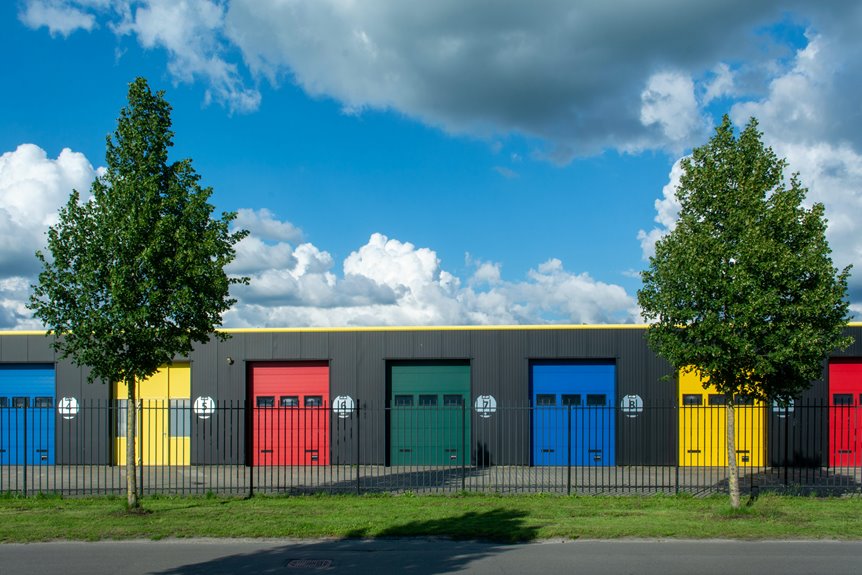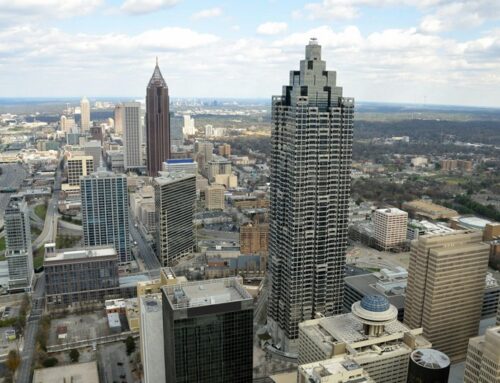Evaluating a commercial property for investment involves scrutinizing various aspects like location, property type, finances, market trends, condition, tenants, leases, and risks. Understanding these factors is essential for making sound investment decisions. However, what sets apart successful investors is not just knowing what to evaluate but how to weigh these aspects effectively. By honing in on specific metrics, employing analytical tools, and leveraging industry expertise, investors can gain a competitive edge in determining the true potential of a commercial property.
Key Takeaways
- Analyze property type alignment with investment goals.
- Assess local market trends, demand, and competition.
- Conduct financial evaluation for ROI maximization.
- Consider property condition and maintenance costs.
- Review tenant mix, leases, risks, and opportunities.
Location Analysis
When evaluating a commercial property for investment, I always begin with a thorough location analysis. The location of a property is essential as it can greatly impact its value and potential for return on investment. One key aspect I consider is the accessibility of the location. Proximity to major roads, highways, public transportation, and airports can enhance the property's appeal to potential tenants or buyers.
Additionally, I assess the surrounding area to understand the demographic profile, economic activity, and competition in the vicinity.
Moreover, I examine the local market trends and growth potential. Understanding the demand for commercial properties in the area, vacancy rates, and rental prices helps me gauge the property's income-generating potential.
Furthermore, I look into the regulatory environment in the location, including zoning laws, building codes, and tax incentives that could impact the property's development and operation.
Property Type Consideration
In my assessment of a commercial property for investment, I carefully consider the type of property to determine its suitability for my investment goals. Understanding the nuances of different property types helps me make informed decisions and maximize the potential return on my investment.
- Property Use: I evaluate whether the property is intended for office space, retail, industrial, or mixed-use purposes to align with my investment strategy.
- Market Demand: I analyze the current market demand for the specific property type to make certain there's a consistent interest from potential tenants or buyers.
- Maintenance Requirements: I assess the maintenance needs associated with the property type to estimate ongoing costs and avoid unexpected expenses.
- Future Growth Potential: I investigate the potential for future growth and development in the area related to the chosen property type to capitalize on appreciation and rental income opportunities.
Financial Evaluation
Considering the potential returns on my investment, I analyze the financial aspects of the commercial property, focusing on its valuation and revenue-generating capabilities. One crucial aspect of financial evaluation is the property valuation. This involves determining the current market value of the property through methods like comparable sales analysis or income capitalization. Additionally, assessing the revenue-generating capabilities is vital. This includes analyzing the property's current and potential rental income, as well as factoring in expenses such as maintenance costs and property taxes.
—
| Financial Aspect | Description |
|---|---|
| Property Valuation | Determining the market value through methods like comparable sales analysis or income capitalization. |
| Revenue Generation | Analyzing current and potential rental income, considering expenses such as maintenance costs and property taxes. |
Market Research
I'll start by emphasizing three key points for conducting thorough market research before investing in a commercial property.
Firstly, it's essential to analyze local trends to understand the direction in which the market is heading.
Secondly, evaluating the competition and demand in the area will provide valuable insights into the property's potential success.
Lastly, considering economic indicators will help in predicting future growth and stability within the market.
Analyze Local Trends
After conducting thorough market research, I've identified several key local trends that will impact the evaluation of this commercial property for investment.
- Population Growth: The area has been experiencing a steady increase in population over the past few years, indicating a growing demand for commercial spaces.
- Infrastructure Developments: Ongoing infrastructure projects like new highways and public transportation systems are enhancing accessibility to the property, potentially increasing its value.
- Economic Stability: The local economy has shown resilience, with diverse industries thriving. This stability bodes well for the property's long-term sustainability.
- Changing Demographics: Shifts in demographics, such as an influx of young professionals or retirees, could influence the types of businesses that would thrive in the area.
Analyzing these local trends provides valuable insights into the potential performance and value appreciation of the commercial property, guiding sound investment decisions.
Assess Competition and Demand
I conducted comprehensive market research to assess the competition and demand for the commercial property before making any investment decisions. Understanding the competitive landscape is vital in determining the property's potential for success. I examined the types of businesses nearby, their offerings, and pricing strategies. This analysis allowed me to gauge how the property would fit into the existing market and whether there was room for growth or saturation.
Additionally, I investigated the demand for similar properties in the area. By looking at factors such as population growth, employment rates, and demographic trends, I could anticipate the level of interest in the property. High demand indicates a healthy market where the property could thrive, while low demand could signal potential challenges in attracting tenants or buyers.
Consider Economic Indicators
How do economic indicators influence the decision-making process when evaluating a commercial property for investment?
Economic indicators play an essential role in determining the feasibility and potential success of a commercial property investment. By analyzing these indicators, I can better understand the market conditions and make informed decisions.
Here are some key economic indicators that impact my evaluation process:
- GDP Growth: A growing GDP indicates a healthy economy with increased business activities, potentially leading to higher demand for commercial properties.
- Interest Rates: Fluctuations in interest rates influence borrowing costs, impacting the affordability of investments and the overall attractiveness of commercial real estate.
- Unemployment Rates: Lower unemployment rates suggest a stable job market, which can translate to higher consumer spending and increased demand for commercial spaces.
- Inflation Rates: Monitoring inflation helps me assess the purchasing power of tenants and the potential rental income growth of the property.
Considering these economic indicators allows me to make well-informed decisions when evaluating commercial properties for investment.
Condition Assessment
When evaluating a commercial property for investment, the condition assessment is essential. Key aspects include:
- Conducting a thorough exterior inspection
- Evaluating the functionality of interior systems
These points help determine the property's current state and potential investment value.
Exterior Inspection Key
Conducting a thorough exterior inspection is essential when evaluating a commercial property for investment. The exterior of a property provides valuable insights into its overall condition and potential maintenance costs.
Here are some key points to focus on during the exterior inspection:
- Roof: Check for any signs of damage, missing shingles, or areas prone to leaks. A well-maintained roof is vital for protecting the interior of the building from weather elements.
- Facade: Inspect the exterior walls for cracks, peeling paint, or signs of water damage. The facade's condition can impact the property's curb appeal and overall value.
- Windows and Doors: Look for any broken windows, damaged frames, or malfunctioning doors. Properly sealed and functional windows and doors enhance security and energy efficiency.
- Parking Lot and Landscaping: Evaluate the condition of the parking lot for potholes, cracks, and proper drainage. Additionally, assess the landscaping for maintenance needs, such as overgrown vegetation or dying trees. A well-kept exterior space contributes to a positive first impression for potential tenants or customers.
Interior Systems Evaluation
During my assessment of the commercial property, I prioritize evaluating the condition of its interior systems. This step is vital as it gives insights into potential maintenance costs and the overall functionality of the property. Below is a table outlining key areas I focus on during the interior systems evaluation:
| Interior System | Assessment Criteria | Importance Level |
|---|---|---|
| HVAC System | Age, efficiency, maintenance | High |
| Electrical Wiring | Up-to-date, safety standards | High |
| Plumbing | Leakages, water pressure | Medium |
| Fire Safety Features | Alarms, sprinkler systems | Medium |
| Interior Lighting | Type, condition, energy efficiency | Low |
Tenant Analysis
One essential aspect when evaluating a commercial property for investment is analyzing the current and potential tenants. Understanding the tenant mix and stability can greatly impact the property's long-term profitability. Here are key points to take into account:
- Tenant Quality: Evaluate the reputation and financial stability of existing tenants. Strong, reputable tenants can provide a steady income stream and enhance the property's value.
- Lease Terms: Review lease agreements to determine lease expiry dates, rental rates, escalation clauses, and any special conditions. This helps forecast cash flow and potential risks.
- Tenant Diversification: Examine the diversity of tenants across industries to mitigate risks associated with economic downturns impacting a specific sector.
- Vacancy Rates: Analyze current vacancy rates and historical trends. High vacancy rates could indicate underlying issues that may affect the property's profitability.
Lease Review
When evaluating a commercial property for investment, one vital step is thoroughly reviewing the lease agreements in place. This process involves examining the terms and conditions outlined in the leases to understand the financial obligations of both the landlord and the tenants. By carefully reviewing the lease agreements, I can assess factors such as the length of the leases, rental rates, escalation clauses, renewal options, and any special provisions that may impact the property's income potential.
Additionally, analyzing the lease terms can provide insight into the stability and reliability of the property's cash flow. Long-term leases with reputable tenants can indicate a secure investment, while short-term leases or frequent tenant turnover may pose higher risks.
Furthermore, reviewing the lease agreements allows me to identify any potential issues or discrepancies that could affect the property's value or future profitability. Understanding the rights and responsibilities outlined in the leases is crucial for making informed investment decisions and maximizing returns on a commercial property.
Risks and Opportunities
Reviewing the lease agreements not only uncovers potential risks but also reveals valuable opportunities for maximizing the commercial property's investment potential. When evaluating a commercial property, understanding the risks and opportunities associated with the lease agreements is essential. Here are some key points to keep in mind:
- Risks:
- High tenant turnover leading to frequent vacancies.
- Long-term leases with below-market rental rates affecting potential income.
- Opportunities:
- Renegotiating leases to increase rental income.
- Identifying lease clauses that allow for rent escalation based on market conditions.
Frequently Asked Questions
How Does the Property's Zoning Affect Its Investment Potential?
Understanding a property's zoning is essential. It influences what can be built, impacting both income potential and property value. Zoning regulations dictate usage restrictions, affecting the property's flexibility and attractiveness for investment purposes.
What Are the Current and Projected Vacancy Rates in the Area?
In my experience, researching current and projected vacancy rates is essential. It provides insight into market demand and potential income. Analyzing this data helps make informed decisions and guarantees the property aligns with investment goals.
How Might Upcoming Infrastructure Projects Impact the Property's Value?
Upcoming infrastructure projects can greatly impact a property's value by increasing accessibility and attracting more tenants. This can lead to higher rental rates, increased demand, and ultimately boost the property's overall investment potential.
Are There Any Environmental Concerns or Regulations Affecting the Property?
Like a hidden iceberg, environmental concerns and regulations lurk beneath the surface of a commercial property. It's essential to unearth these potential hazards before investing to avoid being blindsided by costly consequences.
What Are the Property Tax Rates and Potential Tax Incentives Available?
Property tax rates vary by location and can impact investment returns. Researching potential tax incentives is essential for maximizing profits. Understanding these factors guarantees informed decision-making and long-term financial success in commercial property investments.
Conclusion
In summary, evaluating a commercial property for investment is like solving a complex puzzle, where each piece plays a vital role in the overall picture.
By carefully analyzing factors like location, financials, market trends, and tenant stability, investors can uncover the hidden gems and potential pitfalls of a property.
It's a delicate balance of analysis and foresight, but with the right approach, the rewards can be bountiful.











